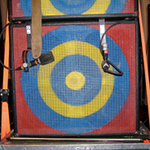Dennis Oppenheim: 500 Words
A pioneer of Earthworks in the late 1960s, Dennis Oppenheim has pursued an adventurous career in sculpture and installation, film and video, and body and performance art, but he never stopped making outdoor work. For the past ten years, Oppenheim has concentrated almost exclusively on public art, which is documented in a new book published by Charta this month.
SOME PEOPLE WOULD SAY the age of experimentation in art has ended, but if it has, it’s also created an opening for a new camaraderie of artists working in architecture and public space, making work with people in mind. Functionality and design—once problematic for fine artists—are now where exciting things are happening. It’s a natural progression, but there’s still some resistance. I have fond memories of operating in a studio as a pure scientist, with absolutely no agenda other than to brainstorm art theory and develop new methods. I miss that. My public art does demand similar responses on my behalf to make it successful, but not at the level of penetration that studio work offers: what art can, should, and can’t be—all these heavy questions.
Public work has to be different; it has to be more like architecture. Public art also has to be fairly durable, and artists have to deal with certain characteristics, such as the democratic way the art is selected. That was never true with body art and Land art, which were often fragile, distributed randomly, and created without an audience. For me, venturing onto this new terrain, I’m often on unsteady ground.
Another reason I’m doing public art is to make a distinction between permanent work and the art I come from, which is partly installation art or ephemeral work. That period wore down, and I intentionally moved to the other extreme. Public art is still a frontier, like Alaska.
Working in public art has made me interested in architecture. Young architects, and those not so young, are doing extraordinary work in the built environment, and somehow they are getting away with it. Aaron Betsky, who directed the 2008 Venice Biennale of Architecture, said all the entries were temporary installations—no one will build a building. If you think about it, how else could it be? But that brings to mind installation art, which occurred more in the ’70s. Architects are looking very much like installation artists from thirty years ago. It’s also interesting how architects working with ephemerality, like those in the biennale, are growing in number, and they’re operating with many different kinds of social attitudes. I have a less social attitude than most of them.
Public art, in many cases, is not as structurally and theoretically advanced as contemporary architecture. Vito Acconci says that architects are more interesting to him than artists. There are sculptors out there who are pushing things, people like Thomas Hirschhorn, with all the masking tape—it’s perverse and wonderful. But there are probably more outrageous architects. Even as they take their cues from artists, architects don’t always need us.
Many of my commissions, such as Jump and Twist, 1999, Wave Forms, 2007, and Flying Gardens, 2005, have an opportunity to integrate closely to the site, which is what panels and municipalities want. In New York City, you can’t really do permanent work. That’s why funding agencies like the Public Art Fund sponsor temporary pieces, but work like that is a hybrid. Real public art is like architecture because it will be there for a while.
Public-art commissions, though, generally have a 20 percent success rate, and projects that get rejected are often shelved because they are site-specific. But you can still use them, present them, and keep them alive by talking about them—it depends on how good they are. Sometimes the best work is not accepted because it’s too radical or ambitious—that’s a paradox of public art. In the past, I’ve sometimes taken elements from a commission and shown them in a gallery—like I did with Garden of Evidence, 2008, a work for Scottsdale, Arizona—before installing them in a site. Funding for an exhibition is sometimes hard to get, so use your public-art commission to construct the work and then show it momentarily in a gallery. Cities don’t always like that.
Device to Root Out Evil, 1997, appears on the cover of the new book, which is partly a decision to retain a singular image because the disparity in my work makes it hard to rest on anything particular. When there is an opportunity to create a signature image, I do, and Device has been on the cover of a few books. But the work has since become discomforting. I donated one of three versions to Stanford University, where I went to graduate school, but after a controversy they gave it back. This upside-down church has been chased around the continent for several years. After Vancouver took it down, it moved to an obscure site in Calgary.
What people don’t realize is how acceptance of permanent work takes time. People have grown to love Antony Gormley’s Angel of the North, 1994–98, in Gateshead, in the northeast of England. I haven’t yet heard that about my work.
—As told to Christopher Howard
Originally published at Artforum.com on October 26, 2009.
